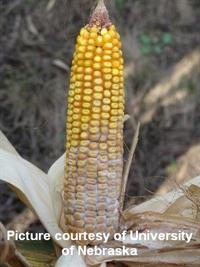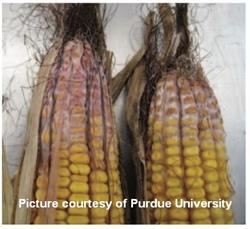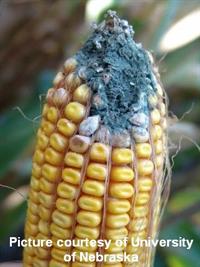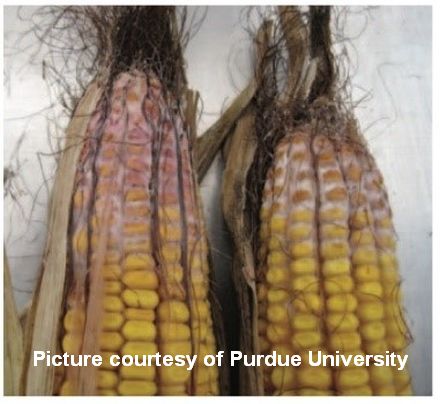AGRONOMICSUPPORT
YOU CAN TAKETO THE FIELD
Kernel Molds and Ear Rots
We are experiencing a corn crop in 2018 that has progressed remarkably fast through its growth stages. Much of this can be contributed to rapid accumulation of heat units. In most areas of the mid-south, we have also received ample moisture to keep the crop moving along. This weather pattern has provided excessive humidity levels that, when coupled with the heat, has created an “incubator” for other issues.
As we have monitored corn fields here in the south, we are finding several issues with insect feeding on the tips of ears. Corn earworm, Japanese beetles and Stink bugs are the most common findings. Assorted smaller beetles have also added to the damage as they use the entry points of the previous pests to do their feeding.
Ear Rots and Molds
Along with the late coming beetles, mold and ear rot issues are appearing in some of the same fields. These problems are around every year, but the degree to which they develop varies widely based crop rotation, residue and weather patterns. Several ear or kernel molds can develop during pollination, but some may also appear later as mentioned above. Listed below are some of the most common rots and molds found in the eastern corn belt:
 Fusarium Ear Rot
Fusarium Ear Rot
- The most prevalent fungal disease on corn ears, occurs every year
- Infections usually enter through damaged areas or kernels
- Infected kernels can be located anywhere on the ear
- Fungus is white to salmon colored
- May produce some mycoxtins
 Diplodia Ear Rot
Diplodia Ear Rot
- Infection usually occurs from innoculum on crop residue
- Corn on corn rotations are more prone to infection if residue is left
- Initial indications are a dead or dying ear leaf
- Husks of infected ears may also dry out prematurely
- Infection usually occurs at the base of the ear but not always
- White fungal growth typically envelopes the ear from base to tip
- There is no true genetic resistance to this diplodia
 Giberella Ear Rot
Giberella Ear Rot
- Wet, cool weather patterns after silking can cause this issue
- Infections at tip of the ear are usually white fungal growth
- Progression of disease down the ear causes a pinkish cast to develop on kernels
- A major concern for producing mycotoxins that can affect animal health
- Swine are most at risk from the mycotoxins

 Penicillium Ear Rot
Penicillium Ear Rot
- Generally, occurs on damaged ears following a wet, humid period
- A blue fungal growth at the tip of a damaged ear is very common
- Mold may also be a greenish blue around kernels and on the cob
Conclusion
Careful monitoring of fields prior to harvest can help head off potential problems with ear rots. Some cases may require earlier than normal harvest and/or isolation of the grain. Drying grain to 15% can reduce the spread of these pathogens in storage, but long-term storage is not recommended. If mycotoxins are suspected, grain should be tested by a certified lab in your area.
For more information or assistance please contact your LG Seeds Sales Area Manager or Technical Team Agronomist.
Sources and Additional Information:
ttps://cropwatch.unl.edu/2016/ear-and-stalk-rot-diseases-becoming-more-common-corn-fields
https://agronomag.com/symptoms-most-common-corn-ear-rots/
https://extension.psu.edu/ear-rots-in-your-corn-crop
https://www.purdue.edu/newsroom/releases/2017/Q4/new-app-makes-it-easier-for-farmers-to-identify,-manage-corn-ear-rots,-mycotoxins.html
Note: The information in this issue is based upon field observations and third-party information. Since variations in local conditions may affect the information and suggestions contained in this issue, LG Seeds disclaims legal responsibility therefore. Always read and follow label instructions.
LG Seeds and design are trademarks of AgReliant Genetics, LLC.
Download a copy of this Technical Bulletin: Tech_390 - Ear Rots and Kernel Molds






Technical Team Agronomist